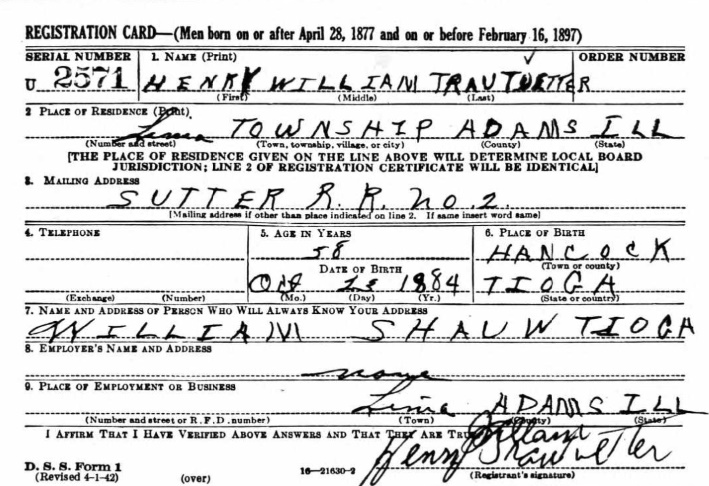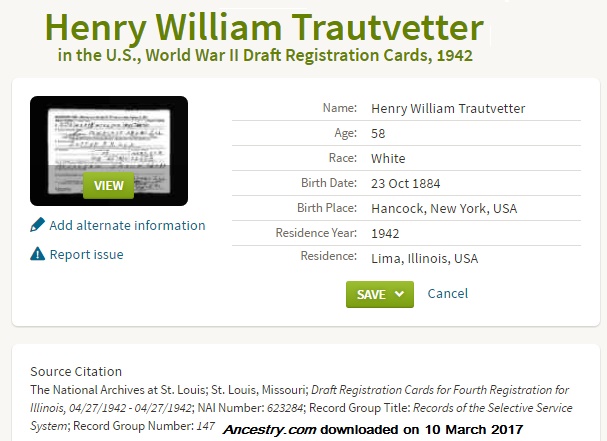Records with clear errors present challenges to transcribers.
Actually they only present transcription challenges when the handwriting is difficult to read. Transcribers are supposed to transcribe records as they appear, not as they wish they would appear and not as they are “supposed” to appear. The directive is fairly clear. When the handwriting is easy to read, errors are not that hard to transcribe. When the handwriting is difficult to read, transcribing an error presents an addition layer of fog for the transcriber to navigate.
The problem is compounded when the information being extracted is being put into a database with pre-populated fields from which the transcriber has to choose.
And that’s the dilemma that likely met the Ancestry.com transcriber of the World War II Old Men’s Draft card for Henry William Trautvetter that appears in their “U.S., World War II Draft Registration Cards, 1942.”
Henry was born in Hancock and Hancock is located in Tioga. That’s not a typographical error.

The printing on the draft card is clear for Trautvetter’s place of birth:
- Town or county: Hancock
- State or country: Tioga
There is no doubt what the card says.
Trautvetter’s card indicated he was living in Lima Township, Adams County, Illinois, when he registered in April of 1942. The person who would “always…know your address” lived in Tioga (no stated listed) suggesting it’s near where Trautvetter lived at the time of the registration. Tioga is also where Trautvetter was born.
Ancestry.com‘s indexer apparently decided that this Hancock in the state of Tioga was actually Hancock in the state of New York. That is how it appears in the database Ancestry.com made to index these cards.

Part of the problem is that to facilitate the indexing of these records to streamline the search process, Ancestry.com has standardized the place names that can be used. There is no state of Tioga and never has been a state of Tioga. Because of this, it does not appear on Ancestry.com‘s list of states. During the indexing process, someone decided that Hancock in the state of Tioga was actually a reference to Hancock in the state of New York.
The database entries at Ancestry.com are not exactly transcriptions–particularly where the place names are concerned. In some cases, they are standardizations made to facilitate search.
And there’s a difference between a standardization and a transcription–just like there is a difference between Illinois and New York.
Note: FamilySearch also has a database of these cards, but as of this writing the Ancestry.com database is more complete than the one at FamilySearch. The one at Ancestry.com is also searchable as well. The images at FamilySearch are alphabetical by state.
Second note: Trautvetter is a brother to George Adolph Trautvetter (1869-1934) my great-grandfather.

4 Responses
So where was he born? And what was the Tioga that he was referring to?
He was born in Tioga (or just outside of it), Hancock County, Illinois. The person completing the card simply got mixed up.
Ohhhh, Tioga, Hancock, Illinois. So he should have put either Tioga or Hancock (which he did) in the top position where it states “Place of Birth” and then Illinois or Hancock in the bottom space. I can see where the transcriber got messed up. I have only ever herd of Tioga as a county of New York.
There are a few Tiogas scattered across the US, but the one in New York is most likely the most well-known. The mistake on the part of the clerk was an easy one to make, especially if there were men standing in line, etc. Ancestry.com should have had some procedure in place for “non-standard” places and how they could be handled instead of just assuming where it was.